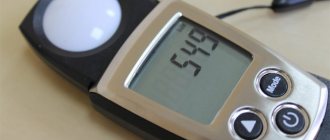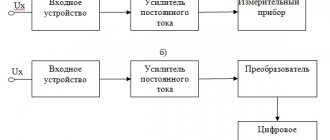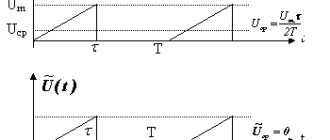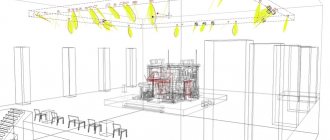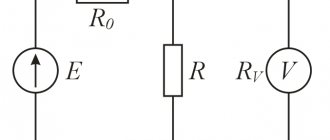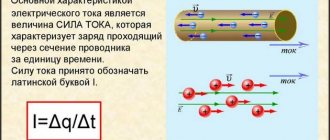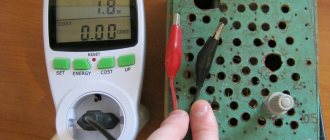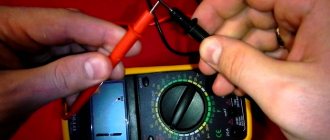Precision is paramount | 12/26/2016
A lux meter is apparently some kind of measuring device. But not everyone will give a clear answer as to what quantity he controls. It’s good if they remember about the lighting in the room or workplace. Indeed, the device is designed to measure one of the characteristics of the lighting environment. We will try to cover this issue in detail: the purpose, principle of operation of the device and methods of its use.
A little theory
There is a lot of confusion on the Internet in scientific and technical terms related to the field of lighting technology. The same device is called differently. The device in question, a lux meter, for example, is sometimes passed off as a luminous flux meter, although it is not.
Luminous flux is a characteristic of a lighting element, and we can talk about this value only in relation to a specific lighting source (incandescent lamp, gas-discharge element, LED, etc.). The SI unit of this characteristic is lumen (lm). This is the luminous intensity of 1 candela (cd) per solid angle of 1 steradian (sr).
This parameter is measured using a photometric ball (spherical integrator) with a diameter of 1 or 2 meters, or with desktop integrating spheres ranging in size from 10 cm to half a meter. All these devices, naturally, are not for household use, since the price of even a small domestic device TKA-KK1 for monitoring LEDs is 35,000 rubles.
The flux of light acting per unit area is expressed by illumination. The unit of this characteristic is lux (lux) - the result of illuminating a surface of 1 m² with a flux equal to 1 lumen. The concept of “illuminance” does not refer to the light source, but to the environment. The luminous flux is a constant value for each source, while the illumination at each point in the room depends on several factors:
- the number of sources located near the measurement site;
- light pressure of each of them;
- distances to sources;
- reflective ability of furnishings.
Criterias of choice
Before purchasing such a device, it would be useful to familiarize yourself with the tips that will help you purchase the best option:
- Measuring range and sensitivity. On sale you can find instruments for measuring solar and ultraviolet radiation, and there are instruments for measuring diode light or neon lamps. When choosing, you should decide in advance what type of light you will have to work with. There are also universal devices, but their cost is much higher than specialized ones.
- Additional options. If you need to analyze several indicators at once (temperature, pressure, noise), pay attention to universal devices. Their cost will also be higher, but they will save you from the need to carry several different devices with you. On the contrary, if you only need the device to measure luminous flux, it is better to choose a simple, budget option.
- Ripple factor. If you need to calculate the value of this indicator, pay attention to professional equipment; household appliances do not provide a function for calculating it.
- Computer compatible. Today there are many professional programs that process data; if you need to transfer data from their device to the device, familiarize yourself with the methods of its implementation in advance. Is it possible to connect via USB or WiFi module.
What is a lux meter and what is it for?
“Measure everything that can be measured, and what cannot be measured, make it measurable” - this aphorism attributed to Galileo confirms that illumination can also be measured. Since its unit is lux (in Greek - light), the device for measuring illumination is called a luxmeter (meter - I measure). It is used both indoors and outdoors. In what cases is it used?
It has been established that both weak and excessively bright light has an adverse effect on processes occurring in the brain. With a lack of lighting, performance decreases, concentration decreases, and drowsiness occurs. Excessively bright light leads to stimulation of the nervous system. Both of these create the preconditions for an accident. Therefore, planned labor safety measures at workplaces include checking the lighting of workplaces. GOST R 55710-2013 sets standards for illumination (in lux) of premises for various purposes. To put it simply, in an office, according to sanitary norms and regulations (SNIP), the illumination should be from 200 to 300 lux.
The process of photosynthesis in plants, which produces nutrients from carbon in the air, occurs under the influence of light. At the same time, plants react differently to temperature conditions and light levels. Almost all cultivated plants and most vegetables develop well in moderate lighting conditions. Other species require high temperatures and light. Therefore, lux meters are used to control and maintain the required illumination for various crops in greenhouses, greenhouses, and botanical gardens.
Measuring the color characteristics of optical radiation sources
General concept of device construction
Devices of NTP TKA LLC for determining the color characteristics of sources (spectrocolorimeters) are based on measuring the spectral composition of optical radiation with subsequent mathematical processing of the results.
The color coordinates of sources are determined by the values of three integrals taken within the visible spectrum:
where Феλ(λ) is the spectral radiation flux density; x‾(λ),y‾(λ),z‾(λ)—specific chromaticity coordinates.
Chromaticity coordinates are calculated:
The photodetector device of the spectrocolorimeter is shown in Fig. 16.
The radiation from the source under study, having passed through the separation to form a spatial characteristic (1), enters the dispersing device. The device is a polychromator (2) with registration of decomposed radiation by a photodiode array (3). The operating spectral range is determined by the nature of the tasks.
When determining the correlated color temperature, the spectral luminosity density Meλ (W m3) of an absolute black body (BL) is determined in accordance with Planck’s law using the formula:
The color coordinates of the black body at a given temperature T are calculated using formulas (17). Then a transition is applied from the color coordinate system x, y CIE 1931 to the more equal-contrast system u', v' CIE 1976 according to the following formulas:
The same color recalculation is performed for the radiation source under study. Then an array of blackbody chromaticity coordinates and a corresponding temperature array are determined.
The minimum distance in space u, v between the chromaticity point of the source under study (u0', v0') and the chromaticity points of the black body line array (ui', vi') (Fig. 17) is determined by the formula:
Rice. 17. Blackbody line in the color coordinate system u',v' jj
The developed TKA-VD spectrocolorimeter is designed to determine the spectral composition of an optical radiation source with subsequent calculation of color coordinates in the selected coordinate system (Fig. 18). The optical design of the device is a polychromator on a diffraction grating with registration of decomposed radiation by a photodiode array. The operating spectral range of the device is (380–760) nm. The signal linearity range reaches six orders of magnitude. Depending on the configuration of the input device, the device operates in both brightness mode and illuminance measurement mode. The spectral resolution of the device does not exceed 3 nm.
Rice. 18. Appearance of the TKA-VD spectrocolorimeter
Design and principle of operation
The basis of any lux meter is a photocell - a semiconductor device in which light quanta transfer their energy to electrons, resulting in an electric current. The current strength is proportional to the amount of illumination in the place where the photodetector is located.
Another element of the lux meter is an analog or digital indicator. In mechanical devices, an electric current converted by a galvanometer causes a rotational movement of the pointer needle. In digital devices, an analog signal (electric current) is converted into a digital signal using an optical-electronic converter, with the result displayed on a liquid crystal display. Structurally, both units (photodetector and converter) are made either in the form of independent elements connected to each other by wire, or in a common housing.
A monoblock is better suited for quick measurements because it weighs less and is more convenient to use. However, inconveniences arise when measuring in hard-to-reach places, from different directions and recording readings. Therefore, when conducting workplace certification, devices with a remote photosensor are most often used. Let's look at some of the most common models.
How to measure lamp parameters
In accordance with GOST R 54944-2012, to measure illumination it is necessary to use instruments with a maximum error of 10%. As a rule, this requirement is met by expensive lux meters, the cost of which is so high that they are not purchased for measuring light parameters in domestic conditions. This was the case until recently, until the RADEX LUPIN , with which you can determine the illumination, pulsation coefficient and brightness.
The measurement error is 10%. lux meter is equipped with a professional photosensor, which has a spectral sensitivity similar to that of the human eye. By filtering UV and IR radiation with a sensor, it is possible to analyze only that part of the light flux that is perceived by the human eye. RADEX LUPIN can be used to check the compliance of light parameters as specified in SanPiN and other regulatory documents of the Russian Federation.
Source
Device for measuring illumination Yu-116
The device is still a Soviet development Yu-116 in the range from 1 to 100,000 lux. It consists of 2 parts: a selenium photocell and a pointer galvanometer, which is used to measure readings. Stored in a case unassembled, which provides reliable protection from damage. Before operation, the photodetector is connected to the converter using a plug.
The meter scale has 2 concentric arc scales. The inner one is graduated from 0 to 30 lux, the outer one - from 0 to 100. The photocell is equipped with a light-scattering attachment consisting of white translucent plastic and an opaque ring. It is designated by the letter “K”, measurements with it are made in the above ranges. There are 3 more filter attachments: M, P and T. When installed in parallel with the base attachment K, the measurement range increases respectively: 10, 100 and 1000 times.
Two buttons on the instrument panel are designed to switch from one scale to another. When the left button is turned on, measurements are made in the ranges: 0 – 30, 0 – 300, 0 – 3000, 0 – 30,000 (when installing the appropriate attachments). When the right one is on: 0 – 100, 0 – 1,000, 0 – 10,000, 0 – 100,000. In addition to the buttons on the case, there is a corrector for setting the dial indicator to the zero position.
The Yu-117 light meter differs from its predecessor only in the large number of buttons. Instead of two scale switching keys, the device is equipped with five range switching buttons, which increases the measurement accuracy. Buttons for turning on the device, power control and a zero control knob have also been added. Both models are powered autonomously - from a galvanic element of the Krona type with a voltage of 9 V. The price of devices from different sellers is from 6 to 10 thousand rubles.
Popular models
Standard
MEGEON 21550.
The model is made in the form of a monoblock. The lux meter is compact and can be measured with one hand. The display is backlit, the interface is simple and clear. Automatically finds the required measurement range. Operates at temperatures from 0 to 40⁰С. There is an automatic shutdown function. Not included in the state register of measuring instruments.
Measuring range: 0-200000 lux.
Accuracy: 3% for measurements up to 10,000 lux; 4% over 10,000 lux.
Overall dimensions: 53×37×165 mm.
MEGEON 21010.
A model with a remote sensor and a special integrated circuit that ensures high measurement accuracy and minimal error. Operates at temperatures from 0 to 40⁰С. Not included in the state register of measuring instruments.
Measuring range: 0 - 50000 lux.
Overall dimensions: 68×28×116 mm.
CEM DT-1300 481639.
A simple, lightweight, convenient model with a remote sensor. Convenient display. Not included in the state register of measuring instruments. No display backlight. The measuring range is set using a knob.
Measuring range: 0 - 50000 lux.
Accuracy: 5% for measurements up to 10,000 lux; 10% over 10,000 lux.
Overall dimensions: 64.5×24.5×188 mm.
Professional
The model is made in the form of a monoblock. The sensor is equipped with a special spectral sensitive eye for high measurement accuracy. Suitable for measurements in enclosed spaces. Included in the state register of measuring instruments. Operates at temperatures from 0 to 50⁰С. Convenient display, clear interface, built-in memory.
Measuring range: 0 - 99999 lux.
Overall dimensions: 46×25×113 mm.
CEM DT-8809A 481929.
Model with remote sensor. Convenient display. Long cable – 150 cm. Automatic shutdown. Connection to computer via USB, built-in memory. For non-standard light sources, no additional calculations are required. Automatic correction for oblique light rays. Not included in the state register.
Measuring range: 0 - 400000 lux.
Accuracy: 3.5% for measurements up to 10,000 lux; 4% over 10,000 lux.
Overall dimensions: 80×40×170 mm.
Radex LUPIN.
Monoblock, can be carried with you on a strap. Lightweight, compact. Built-in additional heart rate monitor function. Simple interface. A special sensor with correction for the spectral sensitivity of the eye and special filters. Built-in battery. Not included in the state register. Operating temperature range: -10⁰С + 40⁰С.
Measuring range: illumination 10 - 200000 lux; brightness 3-70000 cd/m2; ripple factor 1-100%.
How to use a lux meter?
You can quickly and safely find the desired measurement range for a photodetector if you act in a certain sequence:
- Install attachments with maximum light absorption (K and T) on the photodetector, turn on the right button, which corresponds to measuring the maximum illumination - 100,000 lux. If the measuring needle does not respond, turn on the left one (up to 30,000 lux).
- If the arrow does not move, replace the filter with a more transparent one (P) and turn it on in the same sequence: first the right button, then the left one.
- If there is no movement, install a soft filter (M) and perform similar manipulations.
- If in this case, when the left button is pressed, the result is less than 5 lux, remove the base attachment K and end the search.
To move the measured value away from the area of overlap of the two scales (in the region of 5–20 divisions), it is recommended to start counting the measurement from 5 divisions on the inner scale, or from 20 on the outer scale. For this purpose, reference points are marked on the scales.
Remember: excessive illumination of the selenium photosensor may affect the accuracy of the measurements, so follow the given sequence of actions.
Lighting standards in different types of premises
Lumen - a unit of measurement of illumination
As already mentioned, the minimum lighting is determined by the requirements for lighting of certain types of premises. Obviously, the requirements for the amount of light emitted by lighting fixtures in industrial buildings will differ from the lighting standards of residential buildings.
Example of a norm
For clarity, an example of what lux illumination should be in the premises:
- living rooms - 300 lux;
- medical offices - 500 lux;
- rooms intended for cooking - 300 lux;
- bathrooms, toilets and lobbies - 200 lux;
- classrooms - 400 lux.
Of course, this is not the entire list of standards attached to the types of certain premises.
Important! Before adjusting the lux level, you should carefully read the sanitary standards, then being in the room will be comfortable and safe
